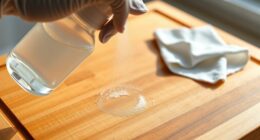Sustainability is reshaping your cleaning practices by elevating eco-friendly products that reduce pollution and improve health. You’ll notice reduced toxic exposure from chemicals and enhanced indoor air quality. Plus, sustainable options often lead to cost savings and promote a positive brand image. Companies are adopting technologies like smart cleaning systems and biodegradable formulas, contributing to waste reduction and resource efficiency. Stick around to discover more about innovative strategies and the future of eco-friendly cleaning solutions.
Key Takeaways
- Eco-friendly cleaning products are becoming mainstream, driven by consumer demand for biodegradable ingredients and non-toxic formulas.
- The cleaning industry is adopting circular economy principles, emphasizing waste reduction through refillable containers and closed-loop systems.
- Technological innovations like IoT devices and robotics enhance resource management and improve cleaning efficiency while minimizing environmental impact.
- Companies are prioritizing social responsibility, engaging in community initiatives, and adopting sustainable practices to build trust with clients.
- The market for eco-friendly cleaning products is projected to grow significantly, reflecting a shift towards sustainability in consumer purchasing behavior.
The Importance of Eco-Friendly Cleaning Products
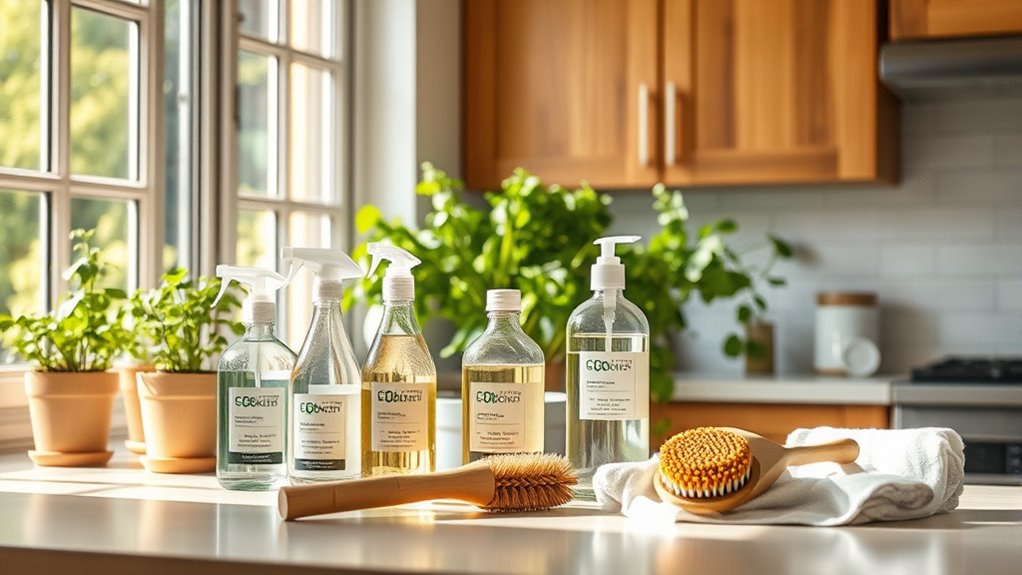
While many people may not realize it, the cleaning products you choose can greatly impact both your health and the environment. By opting for eco-friendly cleaning products, you reduce water pollution thanks to biodegradable ingredients that decompose naturally. This choice also lowers your carbon footprint, as sustainable manufacturing processes minimize CO2 emissions. Additionally, these products often come in recyclable or refillable packaging, which helps cut down on waste. Regular use of eco-friendly products can also support a healthier lifestyle by promoting cleanliness and hygiene.
The cleaning products you choose significantly affect your health and the environment; eco-friendly options make a positive difference.
You’ll also experience health benefits; with no harmful chemicals like ammonia or bleach, you reduce toxic exposure and guarantee a safer home for children and pets. Moreover, choosing sustainable products contributes to preserving the planet for future generations. For instance, using natural cleaning solutions can significantly decrease the number of harmful substances released into the environment. Incorporating mindfulness practices can further enhance your approach to cleaning, making it a more intentional and health-focused activity. Additionally, implementing floral arrangements in your living space can create a more inviting and fresh atmosphere, complementing the benefits of eco-friendly cleaning.
Plus, improved indoor air quality will lead to fewer allergies and respiratory issues, making your living space healthier for everyone.
Economic Advantages of Sustainable Cleaning Practices

Choosing eco-friendly cleaning products not only benefits your health and the environment but also presents significant economic advantages. The sustainable cleaning market is projected to grow, often outpacing traditional options, which can enhance your bottom line. While the initial investment in eco-friendly supplies might be higher, you’ll save money long-term through efficient formulations and reduced consumption. Additionally, using energy-efficient equipment can further minimize operational costs and resource use, allowing businesses to reduce energy bills significantly.
By minimizing resource use and adopting energy-efficient equipment, you’ll cut down on operational costs. Eco-friendly practices in cleaning can lead to significant savings, similar to those experienced with wood stoves in heating. Reusable supplies and refillable solutions further decrease waste and material expenses. Moreover, implementing long-term financial planning for sustainable practices can lead to greater financial stability over time. Air purifiers can also play a role in improving indoor air quality, supporting overall health, and adding to the economic advantages of sustainable cleaning practices.
Plus, prioritizing sustainability can elevate your brand image, attracting loyal clients and potentially earning tax incentives. Embracing these practices not only improves your finances but also positions you as a leader in an increasingly eco-conscious market.
Social Responsibility in the Cleaning Industry
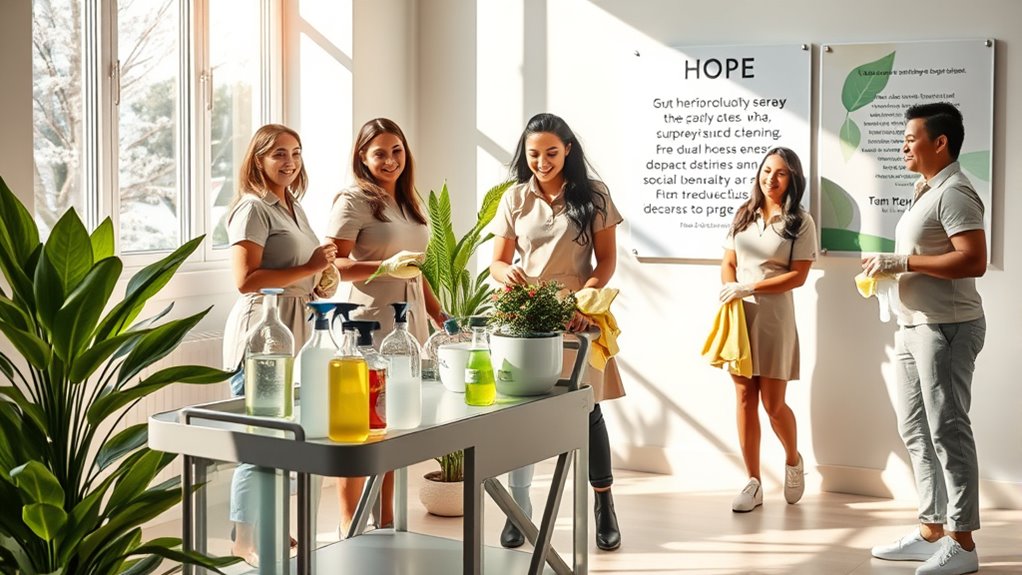
As the cleaning industry evolves, social responsibility has become a vital aspect of business operations, impacting not just the environment but also communities and employees. Companies are prioritizing eco-friendly practices, like using biodegradable products and energy-efficient equipment, to minimize their environmental footprint. This includes Cleanovation efforts aimed at optimizing product performance while reducing environmental impact. Sustainable living practices, such as reducing waste and conserving resources, are also gaining traction in this sector. Implementing strategies like the “one in, one out” rule can further enhance organizational efficiency in homes and workplaces. Engaging in sustainable practices not only benefits the environment but also aligns with the principles of holistic development seen in initiatives like Waldorf toys, which emphasize natural materials and community involvement.
Community engagement is also key; many organizations donate to local charities and support employment opportunities for diverse groups. Ensuring employee welfare through safe working conditions and proper training enhances overall job satisfaction. By embracing transparency and integrity, cleaning companies build trust with clients and communities alike. Ultimately, these social responsibility initiatives not only foster a positive workplace culture but also contribute to healthier, more sustainable communities.
Technological Innovations Driving Sustainable Solutions
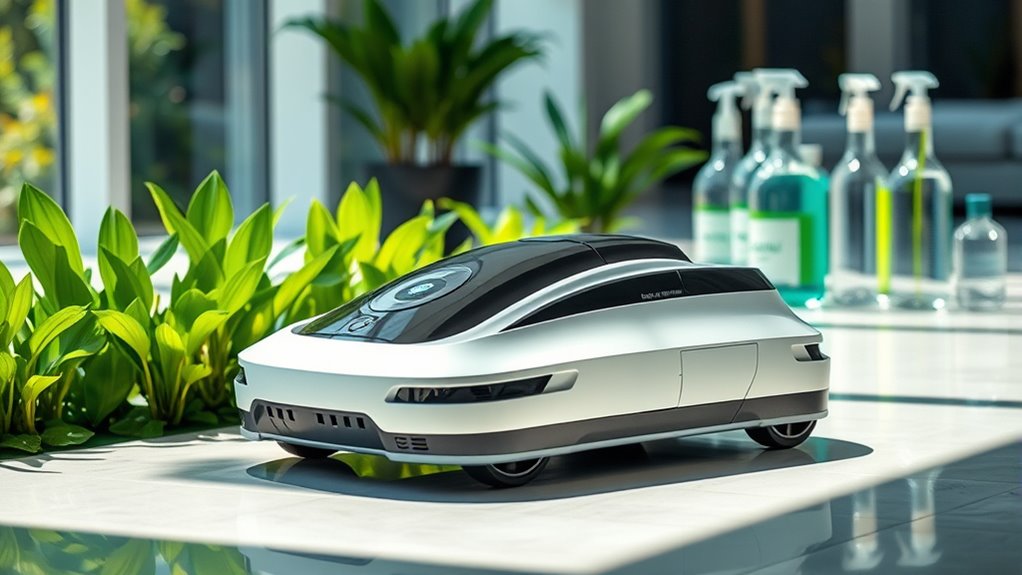
The cleaning industry’s commitment to social responsibility naturally paves the way for embracing technological innovations that drive sustainable solutions. You can leverage aqueous ozone technology and electrolyzed water to produce non-toxic cleaning agents, minimizing chemical reliance. Microfiber materials enhance cleaning efficiency, using less water and fewer chemicals. Aqueous ozone technology not only transforms water into an effective cleaning solution but also eliminates the need for harsh chemicals in the process. Additionally, HEPA filtration is increasingly incorporated into cleaning devices to capture airborne allergens, enhancing overall hygiene. Furthermore, utilizing high refresh rates in smart cleaning devices can optimize their performance, ensuring thorough cleaning in less time. Regular maintenance of air purifiers can also contribute to a cleaner environment, enhancing air quality and reducing pollutants. Airless paint sprayers offer a similar advantage in painting applications, reducing the need for multiple coats and enhancing efficiency. Robotics and smart devices automate processes, optimizing resource use and convenience. Additionally, you’ll find that data-driven analytics and IoT devices help refine cleaning schedules, ensuring efficient resource allocation. With biodegradable agents, concentrated formulas, and refillable containers, you contribute to reducing waste and pollution. These innovations not only enhance hygiene standards but also lead to significant cost savings, making your cleaning practices both effective and environmentally friendly.
Lifecycle Analysis and Circular Economy Principles
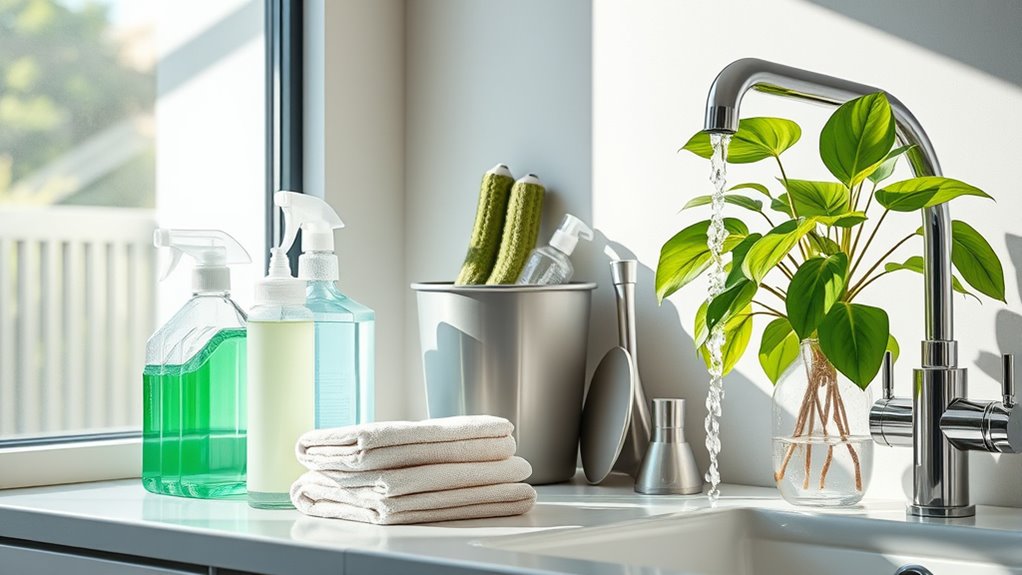
Understanding lifecycle analysis (LCA) and circular economy principles is essential for anyone looking to enhance sustainability in cleaning practices. LCA evaluates environmental impacts throughout a product’s lifecycle, from manufacturing to disposal. By collecting data on inputs and outputs, you can assess effects on climate change and resource depletion. Tools like Ecoinvent and SimaPro streamline this process, similar to how Newbottomline 401k offers tailored solutions for optimizing investments. Additionally, implementing strategies from solar panel maintenance can guide sustainable cleaning practices by ensuring efficiency and longevity. Regular maintenance, such as filter replacement, is crucial for maximizing the effectiveness of cleaning equipment and reducing waste. To further improve sustainability, consider adopting integrated pest management techniques that focus on natural pest control methods.
Circular economy principles emphasize designing products for reuse and minimal waste. You can implement closed-loop systems that recycle materials, reducing reliance on single-use items. Resource consumption is a critical aspect that should be considered when optimizing cleaning practices to ensure minimal environmental impact. Focus on sustainable material selection and optimize manufacturing to cut emissions. Finally, educate consumers on proper disposal methods to support a circular approach. Integrating these strategies can greatly improve the sustainability of cleaning practices.
Consumer Influence on Market Trends
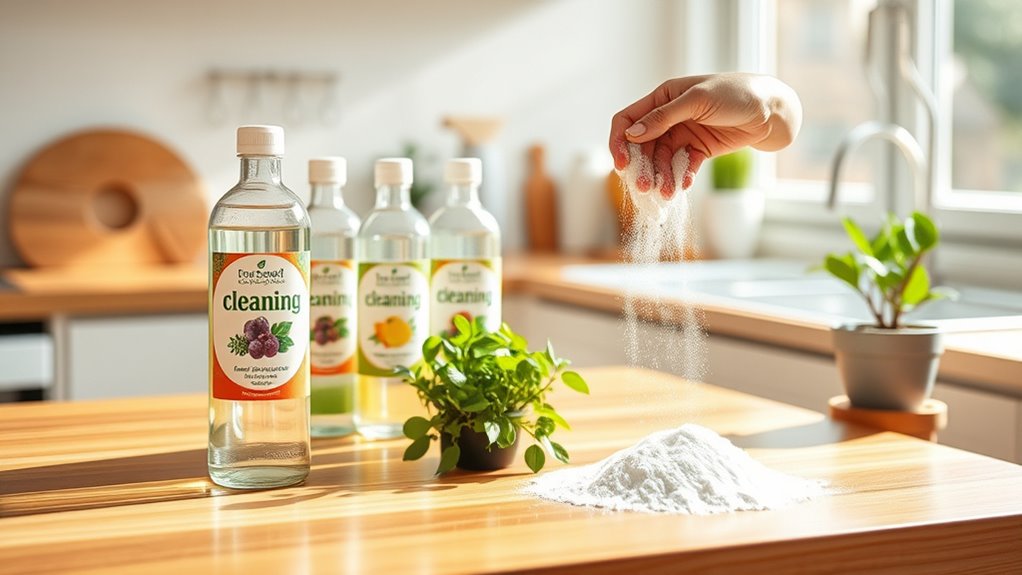
How are consumers shaping the cleaning product market today? You’re becoming increasingly aware of the environmental impact of traditional cleaning products, driving a strong demand for sustainable alternatives.
With health and safety top of mind, you’re opting for eco-friendly options to avoid harsh chemicals. By 2026, sustainable cleaning products are projected to make up over half the market, highlighting your influence. The eco-friendly cleaning products market was valued at USD 5,237 million in 2022, demonstrating the significant growth fueled by your preferences. Additionally, consumers are exploring unique homemade fruit juice recipes that prioritize health and sustainability, reflecting a broader trend towards conscious living. This shift is also supported by research-backed articles that provide credible information on the benefits of eco-friendly choices. Furthermore, many consumers are seeking products that offer antioxidant properties, which can promote overall health and wellness. As part of this movement, green cleaning has become a key focus in low light office plants, helping to create healthier indoor environments.
You’re also seeking brands that align with your values, prioritizing environmentally-conscious choices and low-tox products. As a result, businesses are responding by offering refillable and concentrated options to reduce waste.
Your purchasing decisions reflect a significant shift towards greener, safer cleaning solutions, reshaping the entire industry landscape.
Strategies for Implementing Sustainable Cleaning
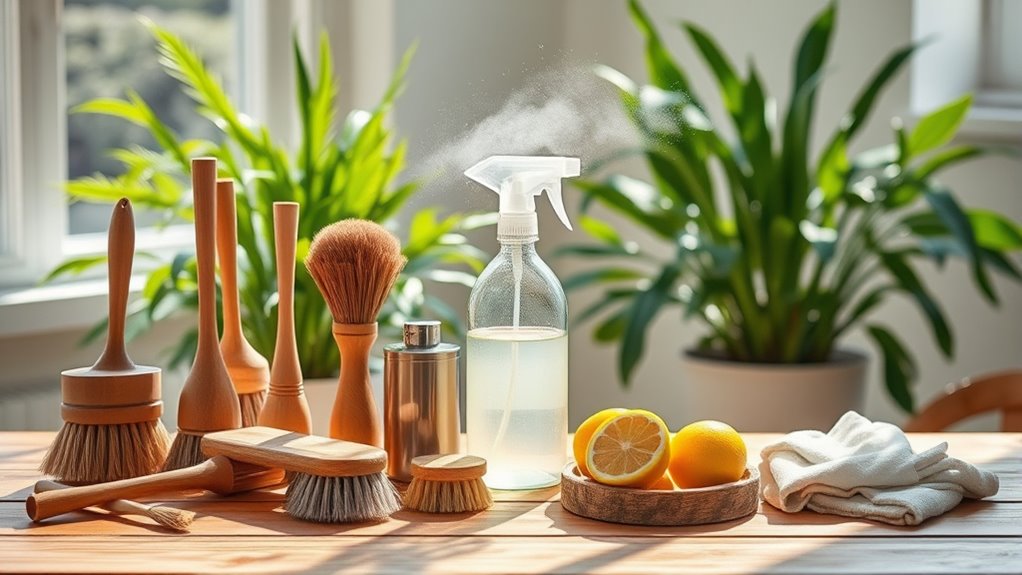
As you aim for a cleaner, greener home, implementing sustainable cleaning strategies becomes essential.
Start by choosing eco-friendly products certified by Green Seal or EcoLogo, ensuring they meet environmental standards. Opt for biodegradable ingredients and non-toxic formulas to protect both your health and local water sources. Additionally, using castile soap as a versatile cleaning solution can help reduce reliance on multiple products. Mindful decluttering can also help in managing cleaning supplies, preventing unnecessary purchases and waste. Incorporating eco-friendly materials in your cleaning tools can further enhance sustainability efforts, making the use of natural fibers a great option for cleaning cloths. Regular maintenance of cleaning equipment, such as air purifiers, ensures they operate at peak performance and contribute to improved air quality.
Incorporate reusable tools like microfiber cloths and bamboo products to minimize waste.
Optimize your cleaning routine by using cold water and efficient schedules, and make sure to maintain your equipment regularly for peak performance. Additionally, consider refilling cleaning containers to reduce plastic waste and compost organic materials instead of sending them to landfills.
The Future of Cleaning in a Sustainable World

While the cleaning industry faces increasing pressure to adopt sustainable practices, it’s clear that the future lies in innovative solutions that prioritize both effectiveness and environmental responsibility.
You’ll see a surge in eco-friendly products made from natural, biodegradable ingredients, alongside concentrated formulas that minimize waste. Innovations in custodial work will include smart cleaning systems, robotics, and advanced materials that significantly reduce the environmental impact.
Technology will play an essential role, with automation and IoT devices enhancing efficiency and resource management.
Automation and IoT innovations will revolutionize the cleaning industry, driving efficiency and optimizing resource management for a sustainable future.
Companies like Unilever are committing to using renewable materials, aligning with global sustainability goals like net-zero emissions by 2050.
As consumer demand for green products grows, you can expect a shift toward sustainable packaging and advanced cleaning techniques that not only improve indoor air quality but also promote a healthier planet.
Frequently Asked Questions
What Are the Main Ingredients in Eco-Friendly Cleaning Products?
When you look for eco-friendly cleaning products, you’ll find key ingredients like baking soda, which absorbs odors, and Castile soap, made from plant oils.
Vinegar serves as a disinfectant, while lemon juice cuts grease. Essential oils add fragrance and antibacterial benefits.
You might also encounter natural alternatives like tea tree oil and hydrogen peroxide for disinfecting.
These ingredients not only clean effectively but also minimize your impact on the environment.
How Can I Identify Certified Sustainable Cleaning Products?
Choosing certified sustainable cleaning products is like steering through a treasure map.
Start by looking for logos like EPA Safer Choice or Green Seal; these indicate safety and environmental standards.
Verify authenticity through certifying body websites to avoid greenwashing.
Check for transparency with complete ingredient lists and sustainable packaging.
Finally, assess the product’s environmental impact, focusing on biodegradability and chemical composition.
This way, you’ll uncover truly eco-friendly treasures for your cleaning needs.
Are There Any DIY Eco-Friendly Cleaning Solutions?
Absolutely, there are plenty of DIY eco-friendly cleaning solutions you can whip up!
For an all-purpose cleaner, mix equal parts distilled white vinegar and water, adding a few drops of your favorite essential oil for fragrance.
Baking soda makes a great stain remover; just sprinkle it on the area, let it sit, and scrub.
You can also use Castile soap diluted in water for a gentle yet effective cleaner.
Enjoy your natural cleaning!
What Are Common Misconceptions About Eco-Friendly Cleaning?
You might think eco-friendly cleaning products are ineffective, but consider a family using a plant-based cleaner to tackle tough kitchen grease. They find it works just as well as conventional products.
Common misconceptions include the belief that green products are hard to find or excessively expensive. In reality, they’re widely available and often affordable.
Additionally, many eco-friendly options are rigorously tested for safety, ensuring they’re both effective and healthy for your home environment.
How Do I Properly Dispose of Eco-Friendly Cleaning Products?
To properly dispose of eco-friendly cleaning products, always follow the manufacturer’s guidelines.
If the product is biodegradable, you might be able to dilute it with water before disposal.
For non-biodegradable items, check for local hazardous waste collection programs.
Look for eco-friendly certifications on products to guarantee they’re safe for the environment.
Conclusion
As you embrace sustainable cleaning practices, you’re not just tidying up your space; you’re part of a larger movement echoing the wise words of Gandhi, who said, “Be the change you wish to see in the world.” By choosing eco-friendly products and supporting innovative solutions, you’re investing in a healthier planet and a brighter future. Remember, every small action contributes to a cleaner, greener tomorrow. Together, let’s scrub away the old and polish up a sustainable legacy.








